The Islamic State and its Baathist allies have forced Iraqi troops that were attempting to retake Tikrit to withdraw from the city just one day after launching a much touted offensive.
Iraqi forces, which include regular Army units, paramilitary SWAT teams, and hastily raised Shia militias from the south, launched their offensive, called Decisive Sword, to regain control of the capital of Salahaddin province with much fanfare yesterday morning. The military claimed to take control of much of the southern part of the city, as well as a hospital and a police academy.
But the assault force “retreated from Tikrit before sunset on Tuesday … after coming under heavy mortar and sniper fire,” Reuters reported.
The Salahaddin Division of the Islamic State claimed on its Twitter page that its forces stopped the Iraqi assault force on the southern outskirts of Tikrit. The jihadist group also claimed that a “Libyan Brother” known as “Okasha” was killed while launching “a martyrdom operation,” or suicide attack, against Iraqi forces. The Salahaddin Division also said two other foreign suicide bombers, “Abu Abdullah Azerbaijani” and “Abu Shaybah Jazrawi,” (a Saudi), launched suicide attacks near Samarra and killed or wounded dozens of soldiers. The reports could not be confirmed.
The Salahaddin Division celebrated its victory and published photographs of the aftermath of the battle on its Twitter feed. The images included Islamic State fighters holding their flags while standing on top of abandoned or destroyed Iraqi military vehicles, including US-made HUMVEEs, as well a captured banner of a Shia militia.
The Salahaddin Division has also claimed it shot down an Iraqi military helicopter yesterday, however the report has not been confirmed. Islamic State fighters have shot down at least one Iraqi military helicopter in Tikrit.
The Iraqi military has now failed at its second attempt to retake Tikrit, which fell to the Islamic State and its allies on June 11. At the end of June, Iraqi forces air assaulted into Tikrit University to the north of the city while ground forces advanced from the south. That offensive stalled and Iraqi forces withdrew from the city after heavy fighting.
The latest failed Tikrit offensive highlights the deteriorating condition of the Iraqi armed forces. The military has been forced to cobble together units after at least four of Iraq’s 16 regular army divisions are no longer viable (note, The Long War Journal estimates that at least seven divisions have been rendered ineffective since the beginning of the year; see Threat Matrix report, US advisers give dark assessment of state of Iraqi military).
In Tikrit, the military is fighting alongside poorly trained militias who are ill-suited to conduct offensive operations. Additionally, SWAT forces, while highly trained and likely more motivated than regular forces, are being misused as infantry.
The Iraqi military and the government have been unable to regain control of Ninewa and much of Salahaddin and Diyala provinces after losing them in an offensive launched by the Islamic State and its allies that began on June 10. Mosul, Iraq’s second largest city, is firmly under the control of the Islamic State.
Most of Anbar as well as northern Babil province are also under the control of the Islamic State. Fallujah and other cities and towns fell after the Islamic State went on the offensive in Anbar at the beginning of January. The Iraqi military has been unable to retake areas in Anbar lost earlier this year. Half of Ramadi, the provincial capital, is said to be under control of the Islamic State. The military recently airlifted 4,000 militiamen to Ramadi, a further indication that the two Iraqi divisions stationed in Anbar, the 1st and the 7th, are no longer cohesive fighting forces.
Photographs of the aftermath of the fighting in Tikrit from the Islamic State’s Salahaddin Division:
An Islamic State fighter raises the group’s banner in front of dozens of abandoned military vehicles outside of Tikrit:
A US-made HUMVEE destroyed in the Iraqi military’s second attempt to retake Tikrit:
An Iraqi police armored vehicle captured by the Islamic State:
Islamic State fighters display a captured banner of a Shia militia:
An Islamic State fighter fires a machine gun at a military helicopter:
A burned-out military truck abandoned during the failed attempt to retake Tikrit:

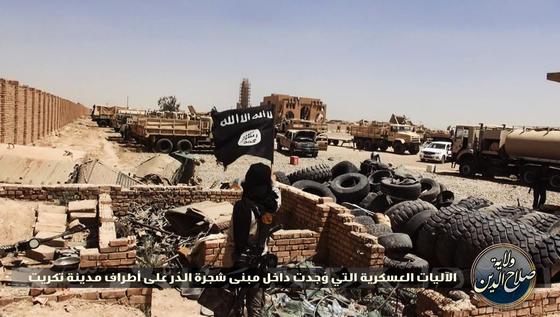
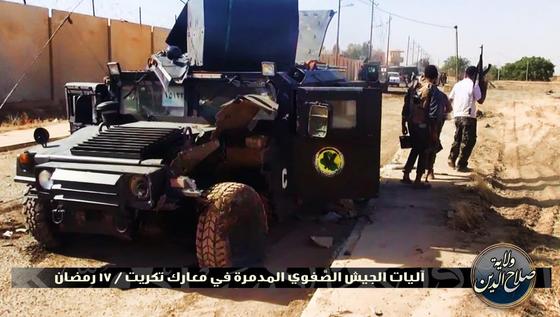
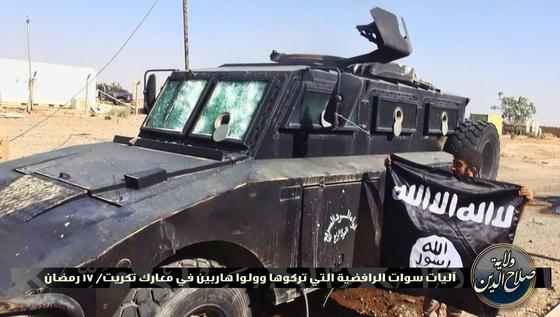
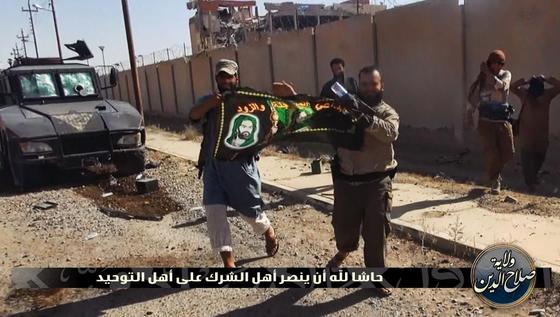
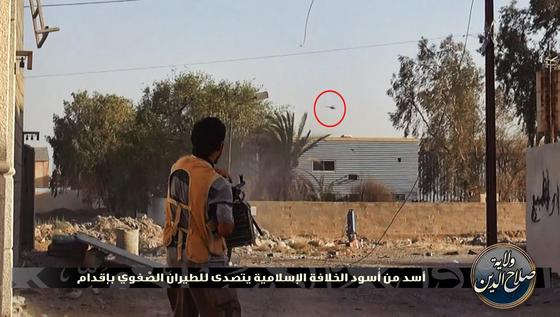
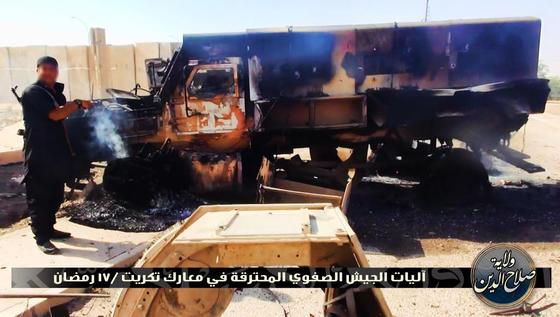







9 Comments
If the government forces can’t do offense, can they surround the city, dig in, and starve Isis out?
I wonder how much political capital Maliki has left. With the election of the Speaker of the Parliament yesterday, is that a sign that maybe a backroom deal is being worked out to oust him? I haven’t seen any data on who voted to approve the Speaker or not and which parties they came from, but that would be interesting to see.
I will be honest. I defended Maliki when some in the Arab press called him “dictatorial” in 2010-2011 when that just seemed like a general insult (kind of like how the term “fascist” gets thrown around as a general insult), but it’s pretty clear that his sectarian leanings and micromanagement of the military has almost wrecked the state. With a normal administration, I’d be hoping our State Department is pounding the phones 24/7 and having people on the ground to work out a deal, but I think the fact that Susan Rice still has a job should tell you everything you need to know.
The question then is: 1) does he go, and if so, how soon, and 2) what do we do if/when that happens?
My predictions in the short term:
1. Kurdistan becomes de facto independent. They basically have been for years now but with Turkey ameliorating their stance, they will be able to sell oil internationally and reap the profits, without interference from Baghdad.
2. Islamic State and IqGov get into a stalemate and no further territory gets exchanged, either way. For IS to push further, they would have to push into largely Shi’ite areas. Also, they will need to actually govern in captured Sunni areas, which may prove harder if the “trains don’t run on time” and if the locals don’t like Sharia law.
3. Maliki eventually gets ousted, but not after a long and protracted fight. Once this happens, the F-16 deliveries that have been “postponed due to XYZ technical issues” magically find themselves delivered.
Well, THAT’s reassuring…
“Vice President Joe Biden is congratulating Iraq’s new parliamentary speaker on his election and says he’ll work closely with him.
Biden spoke to moderate Sunni lawmaker Salim al-Jubouri on Tuesday, after Iraqi lawmakers broke their deadlock by electing him speaker. It’s the first step toward forming a new government as Iraq struggles to confront insurgents.”
http://abcnews.go.com/Politics/wireStory/biden-vows-work-closely-iraqi-speaker-24574144
Ok now this one is interesting. Look on the Iraqi Ambassador to the US’s Twitter, https://twitter.com/FailyLukman
He tweeted this: http://www.washingtoninstitute.org/policy-analysis/view/the-rise-of-isil-iraq-and-beyond-part-i
Quote: “The Iraqi parliament, charged with forming a new government after the March elections, must decide on a prime minister other than Nouri al-Maliki”
Freudian slip…?
Kent, the problem with a siege is that you need to make sure that you don’t starve yourself out. Plus, you have to have control of the surrounding area so you can spread your forces out in an encirclement, without them becoming too vulnerable. Oh, and superior local force. And what about the civilians? Is this a Roman style siege, do you just give them one chance to get out, encircle and then kill every living thing inside?
tl;dr No
However, forcing ISIS into doing sieges against heavily fortified zones might be a more viable strategy. Makes more sense then using air power to lift 15 year old’s into fights they can’t win.
Who are you counting to get 17 IA Divs?
1-14, 17, and ISOF =15
The planned expansion of ISOF to 3 divs was still in infancy – only 1 actually commisioned. {Golden Division]
FP was only 4 Div HQs but bdes for 6. [29]
Now they are 3 Div HQs and bdes for 4. [20]
Most of DBE Region II [Div] can be written off.
Only portion still functional is on Saudi/Jordanian borders or in KRG now.
I’ve said this before: Why are they going after Tikrit now? They need some confidence targets before charging into the belly of the beast. What a waste of men and equipment. If they keep this up there won’t be anything left to defend Baghdad with.
What most military strategist either fail to understand or discount or blissfully would like to forget is the fact that American International Forces were unable to operate freely beyond the ‘Green Zone’ all through their presence in Iraq.
And that US withdrawal from Iraq was not because of any mission accomplishment but rather because of sensing it to be a ‘Mission Impossible’.
If Americans with all their advanced tech paraphernalia could not venture beyond ‘Green Zone’ and have had to eventually wash their ‘bloody hands’ that inflicted so much civilian casualties – then is that any wonder that the ill-equipped, ill-trained and demoralized Iraqi army fled discarding its uniforms?
The only entity capable of ruling Iraq and Syria and any adjoining region as a cohesive unit it would seem is ‘Islamic State’.
The US and Iraqi and Iran controlled Global Media has been cheating the world regarding the ground situations in ‘Iraq’.
There is no point in believing that Media lie of ‘lady reporters’ and ’embedded reporters’ any further, as American failure in Iraq has become a reality.
Unless people accept this reality – I would say they are in ‘Utopia’ – just like ‘Nouri-al-Maliki’ and his Parliamentarians who delude themselves into thinking ‘Iraq’ is yet to be divided.
Kent: It takes more troops to do a seige than an attack – The IA does not have the assets.
Nick: There are no softer targets and Tikrit is strategic. By retaking Tikrit Dirstrict they re-link to KRG and cut ISIS resupply to Diyala. There is nowhere else that the IA can gain more and has the forces available to have anywhere near that effect.